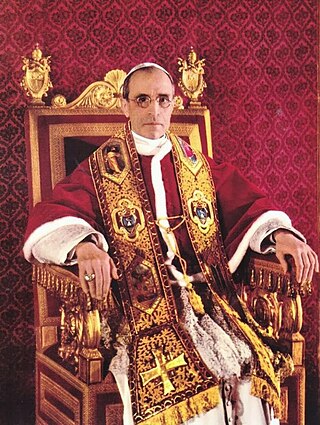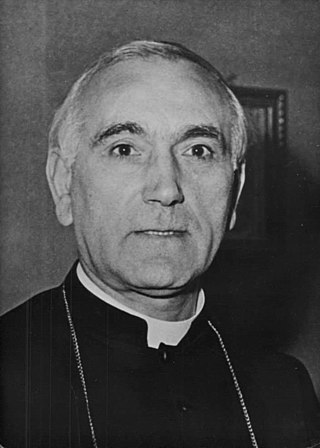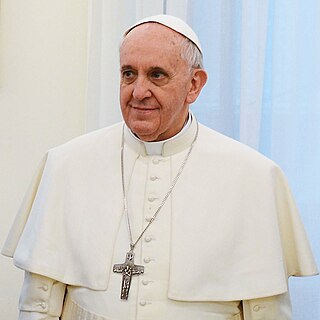
Pope Paul VI was head of the Catholic Church and sovereign of the Vatican City State from 21 June 1963 to his death in August 1978. Succeeding John XXIII, he continued the Second Vatican Council, which he closed in 1965, implementing its numerous reforms. He fostered improved ecumenical relations with Eastern Orthodox and Protestant churches, which resulted in many historic meetings and agreements. In January 1964, he flew to the Hashemite Kingdom of Jordan. This was the first time a reigning pontiff had flown on an airplane, the first papal pilgrimage to the Holy Land, and the first time a pope had left Italy in more than a century.

Giuseppe Siri was an Italian cardinal of the Catholic Church who served as Archbishop of Genoa from 1946 to 1987, and was elevated to the rank of cardinal in 1953. A protege of Pope Pius XII, he was, at one point, considered a papabile.
Papabile is an unofficial Italian term first coined by Vaticanologists and now used internationally in many languages to describe a Catholic man, in practice always a cardinal, who is thought a likely or possible candidate to be elected pope.

A papal conclave is a gathering of the College of Cardinals convened to elect a bishop of Rome, also known as the pope. Catholics consider the pope to be the apostolic successor of Saint Peter and the earthly head of the Catholic Church.

A papal conclave was held on 18 and 19 April 2005 to elect a successor to John Paul II, who had died on 2 April 2005. Upon the pope's death, the cardinals of the Catholic Church who were in Rome met and set a date for the beginning of the conclave. Of the 117 eligible members of the College of Cardinals, those younger than 80 years of age at the time of the death of Pope John Paul II, all but two attended. After several days of private meetings attended by both cardinal electors and non-voting cardinals, the conclave began on 18 April 2005. It ended the following day after four ballots with the election of Cardinal Joseph Ratzinger, Dean of the College of Cardinals and Prefect of the Congregation for the Doctrine of the Faith. Ratzinger was the first member of the Roman Curia to become pope since Pius XII, elected in 1939. After accepting his election, he took the name Benedict XVI.

The papal conclave held from 14 to 16 October 1978 was triggered by the death of John Paul I on 28 September 1978, just 33 days after he was elected pope. The conclave to elect John Paul I's successor ended after eight ballots. The cardinal electors selected Cardinal Karol Józef Wojtyła, Archbishop of Kraków, as the new pope. The third pope in the year, Wojtyła accepted his election and took the name John Paul II.

The papal conclave held on 25 and 26 August 1978 was the first of the two held that year. It was convoked to elect a successor to Paul VI, who had died on 6 August 1978. After the cardinal electors assembled in Rome, they elected Cardinal Albino Luciani, Patriarch of Venice, as the new pope on the fourth ballot. He accepted the election and took the name John Paul I.

A papal conclave took place from 25 to 28 October following the death of Pope Pius XII on 9 October 1958. On the eleventh ballot, the College of Cardinals elected Cardinal Angelo Giuseppe Roncalli as the new pope. He accepted the election and took the name John XXIII. He was the second patriarch of Venice to be elected pontiff in the 20th century after Pius X.

The papal conclave held from 2 to 6 February 1922 saw Cardinal Achille Ratti elected to succeed Benedict XV, who had died on 22 January 1922. It took fourteen ballots for the 53 of the 60 cardinals assembled in the Sistine Chapel to elect a new pope. Ratti took the name Pius XI and immediately revived the traditional public blessing from the balcony, Urbi et Orbi, which his predecessors had eschewed since the loss of Rome to the Italian state in 1870.

The papal conclave held on 1 and 2 March 1939 saw Cardinal Eugenio Pacelli elected on the third ballot to succeed Pius XI, who had died on 10 February, as pope. All 62 cardinals took part. Pacelli, who had been camerlengo and secretary of state, took the name Pius XII. The day was his 63rd birthday.

Giovanni Urbani was an Italian cardinal of the Roman Catholic Church. He served as Patriarch of Venice from 1958 until his death, and was elevated to the cardinalate in 1958. He was considered to be overly dependent upon his advisers.

Gregorio Pietro XV Agagianian was an Armenian cardinal of the Catholic Church. He was the head of the Armenian Catholic Church from 1937 to 1962 and supervised the Catholic Church's missionary work for more than a decade, until his retirement in 1970. He was considered papabile on two occasions, in 1958 and 1963.

Some hold the conspiracy theory which asserts that the conservative Cardinal Giuseppe Siri, then the Archbishop of Genoa, was elected pope in the 1958 papal conclave, taking the name Pope Gregory XVII, but that his election was suppressed. Siri did not associate himself with this idea.

Carlo Confalonieri was an Italian cardinal of the Roman Catholic Church. He served as prefect of the Congregation for Bishops from 1967 to 1973, and dean of the College of Cardinals from 1977 until his death. Confalonieri was elevated to the cardinalate in 1958.

The cardinal electors in the 1963 papal conclave numbered 82, of whom 80 participated. This papal conclave met from 19 to 21 June 1963. This list is arranged by region and within each alphabetically.

The papal conclaves of August 1978 and of October 1978 were respectively convened to elect a pope, the leader of the Catholic Church, to succeed Paul VI and John Paul I following their respective deaths on 6 August 1978 and on 28 September 1978. In accordance with the apostolic constitution Romano Pontifici eligendo, which governed the vacancy of the Holy See, only cardinals who had not passed their 80th birthday on the day on which the conclave began were eligible to participate. Although not formal requirements, the cardinal electors invariably elected the pope from among their number and did so by secret ballot. Due to the brief duration between the conclaves, the respective lists of cardinal electors are nearly identical.

Gustavo Testa was an Italian prelate of the Catholic Church, who was made a cardinal in 1959. He spent his career in the Roman Curia. He entered the diplomatic service of the Holy See in 1920 and held several appointments as papal nuncio from 1934 to 1959. He headed the Congregation for the Oriental Churches from 1962 to 1968.

The 1492 papal conclave was convened after the death of Pope Innocent VIII. It was the first papal conclave to be held in the Sistine Chapel.

Pope Pius XII created 56 cardinals in two consistories. On both occasions Pius tried to bring the membership of the College of Cardinals to 70, the maximum established by Pope Sixtus V in 1586. The death of one cardinal meant his first consistory brought the College to 69 members, but his second consistory, through the prompt addition of another name after a cardinal-designate died, brought the number of cardinals to 70.

A conclave was convened on 12 March 2013 to elect a pope to succeed Benedict XVI, who had resigned on 28 February. 115 participating cardinal-electors gathered. On the fifth ballot, the conclave elected Cardinal Jorge Mario Bergoglio, SJ, Archbishop of Buenos Aires. He took the pontifical name Francis.




















